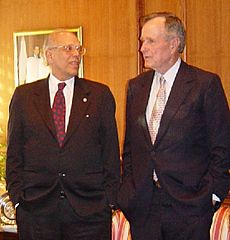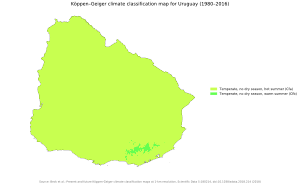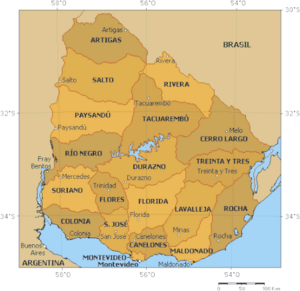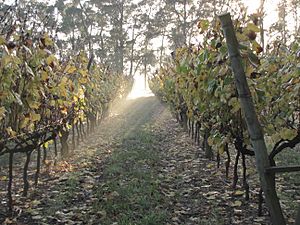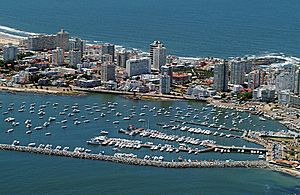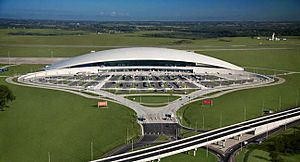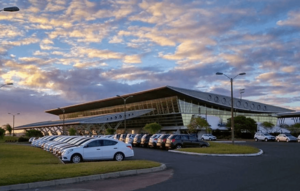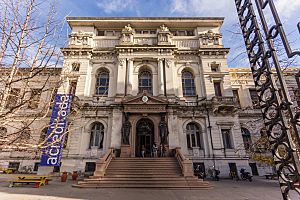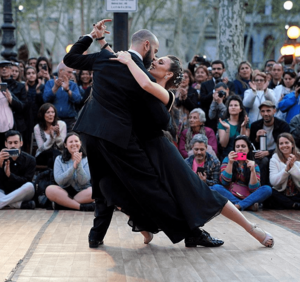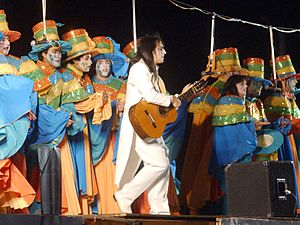Uruguay facts for kids
Quick facts for kids
Oriental Republic of Uruguay
República Oriental del Uruguay (Spanish)
|
|
|---|---|
|
Motto: Libertad o Muerte
"Freedom or Death" |
|
|
Anthem: Himno Nacional de Uruguay
"National Anthem of Uruguay" |
|
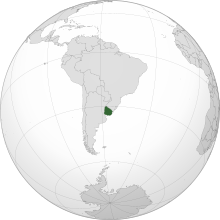
Location of Uruguay (dark green)
|
|
| Capital and largest city
|
Montevideo 34°53′S 56°10′W / 34.883°S 56.167°W |
| Official language |
|
| Ethnic groups
(2023)
|
|
| Religion
(2021)
|
|
| Demonym(s) | Uruguayan |
| Government | Unitary presidential republic |
| Yamandú Orsi | |
| Carolina Cosse | |
| Legislature | General Assembly |
| Senate | |
| Chamber of Representatives | |
| Independence
from Brazil
|
|
|
• Declared
|
25 August 1825 |
| 27 August 1828 | |
|
• Current constitution
|
15 February 1967 |
| Area | |
|
• Total
|
176,215 km2 (68,037 sq mi) (89th) |
|
• Water (%)
|
1.5 |
| Population | |
|
• 2023 census
|
3,499,451 (132nd) |
|
• Density
|
19.5/km2 (50.5/sq mi) (206th) |
| GDP (PPP) | 2024 estimate |
|
• Total
|
|
|
• Per capita
|
|
| GDP (nominal) | 2024 estimate |
|
• Total
|
|
|
• Per capita
|
|
| Gini (2022) | ▼ 40.6 medium |
| HDI (2022) | very high · 52nd |
| Currency | Uruguayan peso (UYU) |
| Time zone | UTC−03:00 (UYT) |
| Date format | dd/mm/yyyy |
| Driving side | right |
| Calling code | +598 |
| ISO 3166 code | UY |
| Internet TLD | .uy |
Uruguay (yoor-Ə-gwy), officially known as the Oriental Republic of Uruguay, is a country in South America. It is also called the Eastern Republic of Uruguay.
Uruguay shares borders with Argentina to its west and southwest. To its north and northeast is Brazil. The country also borders the Río de la Plata to the south and the Atlantic Ocean to the southeast. It is part of the Southern Cone region of South America. Uruguay is about 181,034 square kilometers (69,898 sq mi) in size. It has a population of around 3.5 million people. Nearly 2 million of these people live in the metropolitan area of its capital and largest city, Montevideo.
Contents
What Does the Name Uruguay Mean?
The name Uruguay comes from the Río Uruguay. This river's name comes from the Indigenous Guaraní language. There are different ideas about what it means. One idea is "bird-river," meaning "the river of the uru." The uru is a common name for any wild bird.
Another idea is that the name refers to a river snail called uruguá. These snails were found in large numbers along the river's banks. A famous Uruguayan poet, Juan Zorrilla de San Martín, suggested it means "the river of painted birds." Even if this isn't exactly right, it's a very important idea in Uruguay's culture.
In the past, during Spanish rule, Uruguay and nearby areas were called Banda Oriental, which means "Eastern Bank [of the Uruguay River]." Later, it was called the "Eastern Province." Since gaining independence, the country has been known as "República Oriental del Uruguay." This means "Republic East of the Uruguay [River]." However, it is officially translated as the "Oriental Republic of Uruguay" or the "Eastern Republic of Uruguay."
Uruguay's Journey Through Time
Early Inhabitants of Uruguay
Uruguay was first home to hunter-gatherers about 13,000 years ago. When Europeans first arrived in the 1500s, there were about 9,000 Charrúa people and 6,000 Chaná people. Some Guaraní also lived on islands nearby.
European Arrival and Early Settlements
The Portuguese were the first Europeans to reach the area of Uruguay in 1512. The Spanish arrived in 1515 and claimed the land. The native people fought back strongly against conquest. Also, there were no valuable resources like gold. This meant fewer Europeans settled there in the 1500s and 1600s.
Uruguay became a place where the Spanish and Portuguese empires often fought. In 1603, the Spanish brought cattle, which became a source of wealth. The first lasting Spanish settlement was in 1624 at Soriano. In 1669–71, the Portuguese built a fort at Colonia del Sacramento.
Montevideo, Uruguay's capital today, was started by the Portuguese in the early 1700s. It was a military base. Its natural harbor soon grew into a busy trading area. It competed with Río de la Plata's capital, Buenos Aires. In the early 1800s, Uruguay's history was shaped by ongoing battles. British, Spanish, Portuguese, and other colonial forces fought for control in the Platine region. British forces occupied Montevideo from February to September 1807.
Fighting for Independence
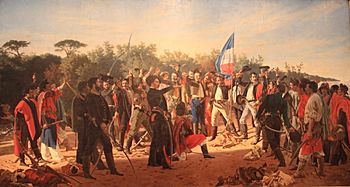
In 1811, José Gervasio Artigas started a successful revolt against the Spanish. He is now Uruguay's national hero. He defeated the Spanish on May 18 at the Battle of Las Piedras.
In 1813, the government in Buenos Aires held a meeting. Artigas wanted each area to have political and economic freedom. But the meeting refused to let delegates from Uruguay join. So, Artigas broke away from Buenos Aires. He took control of Montevideo in early 1815. Uruguay then set up its first independent government. Artigas formed the Federal League with six provinces.
In 1816, 10,000 Portuguese troops invaded Uruguay from Brazil. They took Montevideo in January 1817. After four more years of fighting, the Portuguese Kingdom of Brazil took over Uruguay. They called it "Cisplatina". The Brazilian Empire became independent from Portugal in 1822.
To fight back, the Thirty-Three Orientals, led by Juan Antonio Lavalleja, declared independence on August 25, 1825. They were supported by Argentina. This led to the Cisplatine War, which lasted 500 days. Neither side won clearly. In 1828, the Treaty of Montevideo was signed. This treaty, helped by the United Kingdom, made Uruguay an independent country. August 25 is celebrated as Independence Day. Uruguay's first constitution was adopted on July 18, 1830.
Uruguay in the 1800s
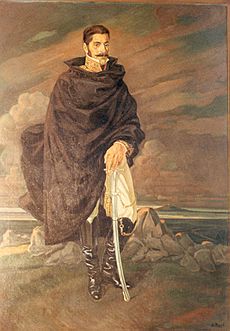
When Uruguay became independent, it had less than 75,000 people. Two main political parties formed. The conservative Blancos (Whites) were led by Manuel Oribe. They represented farmers in the countryside. The liberal Colorados (Reds) were led by Fructuoso Rivera. They represented businesses in Montevideo. These parties got help from fighting groups in neighboring Argentina.
In 1838, the Colorado leader Rivera overthrew President Oribe. Oribe fled to Argentina. Rivera declared war on Argentina's ruler, Manuel de Rosas, in 1839. This conflict lasted 13 years and was called the Guerra Grande (the Great War).
In 1843, an Argentine army attacked Uruguay to help Oribe. But they could not take the capital. The siege of Montevideo lasted nine years. People in Montevideo asked foreigners for help. French and Italian groups were formed, with the Italian one led by Giuseppe Garibaldi.

In 1845, Britain and France stepped in to help trade in the region. Their efforts didn't work well. By 1849, they left after signing a treaty that favored Rosas. It looked like Montevideo would fall. But an uprising against Rosas began, led by Justo José de Urquiza. Brazil also helped the Colorados in May 1851. This changed the situation, and Oribe was defeated. The siege of Montevideo ended, and the Guerra Grande was finally over. Uruguay thanked Brazil by signing treaties. These treaties allowed Brazil to get involved in Uruguay's internal matters.
Brazil used these treaties to intervene in Uruguay many times. In 1865, the Triple Alliance was formed. It included the emperor of Brazil, the president of Argentina, and the Colorado general Venancio Flores. They declared war on Francisco Solano López of Paraguay. The Paraguayan War ended with Paraguay's defeat. Montevideo became a supply station for the Brazilian navy. It had a time of growth and peace during the war.
Uruguay's first railway line was built in 1867. The State Railways Administration of Uruguay now has 2,900 km (1,800 mi) of railway.
General Lorenzo Batlle y Grau (1868–72) stopped a revolt by the Blancos. After two years, a peace agreement was signed in 1872. It gave the Blancos a share in the government. They gained control of four of Uruguay's departments.
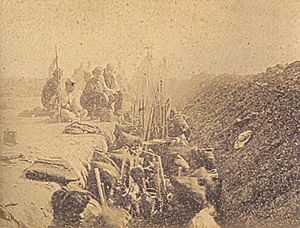
This agreement was a way to find a compromise. It allowed the party in power and the opposition party to work together.
However, the Colorado rule was still challenged. There was a failed revolution in 1875 and another in 1886. The Colorados tried to reduce the Blancos' power to only three departments. This caused a Blanco uprising in 1897. It ended with 16 departments being created. The Blancos now controlled six of them. They also got one-third of the seats in Congress. This sharing of power lasted until President Jose Batlle y Ordonez made new political changes. This led to the last Blanco uprising in 1904. It ended with the Battle of Masoller and the death of Blanco leader Aparicio Saravia.
Between 1875 and 1890, the military held much of the power. During this time, the government worked to modernize the country. They encouraged economic and social changes. Powerful groups like businessmen and farmers influenced the government. After 1886, politicians started to regain power, and civilians became more involved in government.
After the Guerra Grande, many immigrants arrived. Most came from Italy and Spain. By 1879, the country's population was over 438,500. The economy grew quickly, especially in livestock farming and exports. Montevideo became a major trading hub. It was a place where goods from Argentina, Brazil, and Paraguay were exchanged.
Uruguay in the 1900s
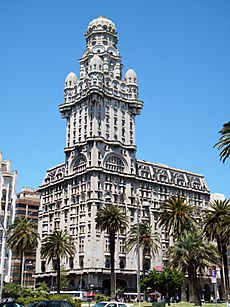
The Colorado leader José Batlle y Ordóñez became president in 1903. The next year, the Blancos started a rural revolt. After eight months of bloody fighting, their leader, Aparicio Saravia, was killed. Government forces won, ending the power-sharing system that began in 1872. Batlle served two terms (1903–07 and 1911–15). During this time, Uruguay was stable and its economy grew. He made big changes, like creating a welfare program. The government also became involved in many parts of the economy.
Gabriel Terra became president in March 1931. His term started during the Great Depression. Many people lost their jobs, causing social tension. There were clashes where police and leftists died. In 1933, Terra took power by force. He closed the General Assembly and ruled by decree. A new constitution was put in place in 1934, giving more power to the president. Terra's government generally reduced economic nationalism and social reforms.
In 1938, elections were held. Terra's brother-in-law, General Alfredo Baldomir, was elected president. Workers and the National Party pushed Baldomir for free elections, freedom of the press, and a new constitution. Baldomir declared Uruguay neutral in 1939. But British warships and the German ship Admiral Graf Spee fought a battle near Uruguay's coast. The Admiral Graf Spee hid in Montevideo, a neutral port. But it was later ordered to leave.
In the late 1950s, demand for Uruguay's farm products dropped worldwide. This caused a big fall in Uruguayans' living standards. It led to student protests and worker strikes. An armed group called the Tupamaros formed in the 1960s. These Marxist-Leninist urban guerrillas tried to overthrow the government.
Military Rule and Return to Democracy
President Jorge Pacheco declared a state of emergency in 1968. More civil liberties were suspended in 1972. In 1973, with growing economic and political problems, the armed forces took control. They were asked by President Juan María Bordaberry. They closed Parliament and set up a civilian-military government. The media was controlled or banned. Trade unions were destroyed. Many books were burned, and some writers' works were forbidden. People who opposed the government were not allowed to work in public service or education. Thousands were illegally held during the 12-year rule (1973-1985). Government spending on social programs was cut. Many state-owned companies were sold off. However, the economy did not get better. It worsened after 1980. The country's GDP fell by 20%, and unemployment rose to 17%. The government tried to help failing companies and banks.
A new constitution, written by the military, was rejected in a vote in November 1980. After this, the armed forces announced a plan to return to civilian rule. National elections were held in 1984. Colorado Party leader Julio María Sanguinetti won the presidency. He served from 1985 to 1990. His government made economic changes and strengthened democracy after the military rule.
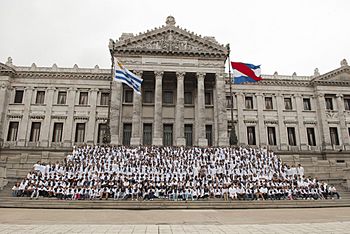
In 2004, Uruguayans elected Tabaré Vázquez as president. His party, the Broad Front, also won a majority in Parliament. Vázquez followed strict economic policies. As prices for goods went up and the economy recovered, he greatly increased foreign investment. He reduced poverty and unemployment. Public debt fell from 79% of GDP to 60%. Inflation remained stable.
In 2014, Tabaré Vázquez was elected president again. His second term began on March 1, 2015. In 2020, Luis Alberto Lacalle Pou became the 42nd President of Uruguay. He is a member of the conservative National Party. This ended 15 years of left-wing government.
Exploring Uruguay's Geography
Uruguay has about 176,214 square kilometers (68,037 sq mi) of land. It also has 142,199 square kilometers (54,903 sq mi) of water and small river islands. This makes it the second smallest country in South America, after Suriname. The land is mostly rolling plains and low hills called cuchillas. There are also fertile lowlands along the coast. Uruguay has 660 kilometers (410 mi) of coastline.
Many rivers and streams flow through the country. There are four main river systems: the Río de la Plata Basin, the Uruguay River, the Laguna Merín, and the Río Negro. The main river inside the country is the Río Negro ('Black River'). Several lagoons are found along the Atlantic coast.
The highest point in Uruguay is the Cerro Catedral. Its peak is 514 meters (1,686 ft) above sea level. This peak is in the Sierra Carapé hill range. To the southwest is the Río de la Plata. This is where the Uruguay River, which forms the country's western border, meets the sea.
Montevideo is the southernmost capital city in the Americas. It is the third most southerly capital in the world. Only Canberra and Wellington are further south. Uruguay is the only country in South America completely south of the Tropic of Capricorn. It is also the southernmost country in the world when looking at its northernmost point.
Uruguay has ten national parks. Five are in the northern wetlands. Three are in the central hill country. One is in the west along the Rio Uruguay.
Uruguay is part of the Uruguayan savanna ecoregion. In 2019, the country had a Forest Landscape Integrity Index score of 3.61/10. This ranked it 147th globally out of 172 countries.
Uruguay's Climate and Weather
Uruguay is in the southern temperate zone. This means it has a mild and fairly consistent climate across the country. Most of Uruguay has a humid subtropical climate (Cfa). Some parts of the Atlantic Coast and the highest hills have an oceanic climate (Cfb). Uruguay experiences four seasons. Summer is from December to March, and winter is from June to September. Temperatures change with the seasons, but extreme temperatures are rare. Summers are cooled by winds from the Atlantic. Very cold winters are not common.
Even though it doesn't get too cold, frosts happen every winter. Sleet and hail also occur almost every winter. Snow is very rare, but it does happen every few years in higher areas. However, it almost never stays on the ground. Because there's a lot of water, high humidity and fog are common. There are no mountains to block the weather. This means all parts of the country can experience strong winds and quick weather changes. These storms can be powerful, bringing squalls, hail, and sometimes even tornadoes. The country has extratropical cyclones but not tropical cyclones. This is because the South Atlantic Ocean is usually not warm enough for them to form. Both summer and winter weather can change daily as storm fronts pass. A hot northerly wind might be followed by a cold wind (pampero) from the Argentine Pampas.
Temperatures and rainfall are quite similar across the country. However, there are some differences. The average yearly temperature is 17.5°C (63.5°F). It ranges from 16°C (61°F) in the southeast to 19°C (66°F) in the northwest. Winter temperatures average from 11°C (52°F) in the south to 14°C (57°F) in the north. Summer average daily temperatures range from 21°C (70°F) in the southeast to 25°C (77°F) in the northwest. The southeast is much cooler, especially in spring. The ocean, which is cold after winter, cools the air and brings more humidity. However, the south gets less rain than the north. For example, Montevideo gets about 1100 mm (43 in) of rain per year. The city of Rivera in the northeast gets 1600 mm (63 in). The most rain falls during autumn. But rainy periods are more frequent in winter. Still, the difference is not big enough to call it a dry or wet season. Droughts or very heavy rains can happen any time of year.
The highest temperature recorded at sea level was 44°C (111°F) in Paysandú (January 20, 1943) and Florida (January 14, 2022). The lowest was −11.0°C (12.2°F) in Melo (June 14, 1967).
How Uruguay is Governed
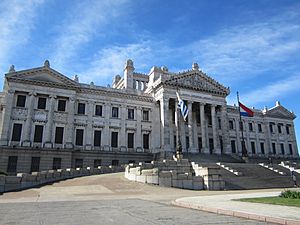
Uruguay is a representative democratic republic. It has a presidential system. Government members are elected for a five-year term. People vote using a universal suffrage system, meaning everyone can vote. Uruguay is a unitary state. This means justice, education, health, security, foreign policy, and defense are all managed by the national government. The President and a cabinet of 13 ministers hold the Executive Power.
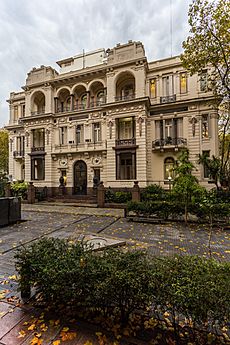
The legislative power is held by the General Assembly. It has two chambers. The Chamber of Representatives has 99 members. They represent the 19 departments and are elected for five years based on proportional representation. The Chamber of Senators has 31 members. Thirty are elected for five years by proportional representation. The vice-president leads this chamber.
The judicial power is held by the Supreme Court, and judges across the country. The General Assembly elects Supreme Court members. The Supreme Court chooses other judges with the Senate's approval.
Uruguay adopted its current constitution in 1967. Many parts of it were stopped in 1973 but brought back in 1985.
Uruguay's Departments and Local Government
Uruguay is divided into 19 departments. Each department has its own local government. These local governments are set up like the national executive and legislative powers. Each department elects its own leaders through universal suffrage. A superintendent leads the department's executive branch. A departmental board holds the legislative power.
| Department | Capital | Area | Population (2011 census) | |
|---|---|---|---|---|
| km2 | sq mi | |||
| Artigas | Artigas | 11,928 | 4,605 | 73,378 |
| Canelones | Canelones | 4,536 | 1,751 | 520,187 |
| Cerro Largo | Melo | 13,648 | 5,270 | 84,698 |
| Colonia | Colonia del Sacramento | 6,106 | 2,358 | 123,203 |
| Durazno | Durazno | 11,643 | 4,495 | 57,088 |
| Flores | Trinidad | 5,144 | 1,986 | 25,050 |
| Florida | Florida | 10,417 | 4,022 | 67,048 |
| Lavalleja | Minas | 10,016 | 3,867 | 58,815 |
| Maldonado | Maldonado | 4,793 | 1,851 | 164,300 |
| Montevideo | Montevideo | 530 | 200 | 1,319,108 |
| Paysandú | Paysandú | 13,922 | 5,375 | 113,124 |
| Río Negro | Fray Bentos | 9,282 | 3,584 | 54,765 |
| Rivera | Rivera | 9,370 | 3,620 | 103,493 |
| Rocha | Rocha | 10,551 | 4,074 | 68,088 |
| Salto | Salto | 14,163 | 5,468 | 124,878 |
| San José | San José de Mayo | 4,992 | 1,927 | 108,309 |
| Soriano | Mercedes | 9,008 | 3,478 | 82,595 |
| Tacuarembó | Tacuarembó | 15,438 | 5,961 | 90,053 |
| Treinta y Tres | Treinta y Tres | 9,529 | 3,679 | 48,134 |
| Total | — | 175,016 | 67,574 | 3,286,314 |
Uruguay's Economy and Industries
Farming and Agriculture in Uruguay
In 2010, Uruguay's farming sector was very important. It made up 9.3% of the country's GDP. It also employed 13% of the workers. Official numbers show that meat and sheep farming use 59.6% of Uruguay's land. This percentage goes up to 82.4% when cattle farming is combined with other activities. These include dairy, growing feed, and rotating crops like rice.
Uruguay is a big producer of several farm products. It ranks among the top countries for soybeans, wool, horse meat, beeswax, and quinces. Most farms (25,500 out of 39,120) are run by families. Beef and wool are the main activities for 65% of these farms. They are also the main source of income. Vegetable farming is next at 12%, then dairy farming at 11%. Raising hogs and poultry each account for 2%. Beef is Uruguay's main export. In 2006, it brought in over US$1 billion.
In 2007, Uruguay had 12 million cattle. This means it had the most cattle per person, at 3.8. However, 54% of the cattle are owned by only 11% of farmers. These farmers have at least 500 cattle. On the other hand, 38% of farmers have small plots. Their herds average less than one hundred cattle.
Tourism in Uruguay: What to See and Do
Tourism is a big part of Uruguay's economy. In 2012, it created about 97,000 jobs. It also contributed about 9% to the country's GDP, directly and indirectly.
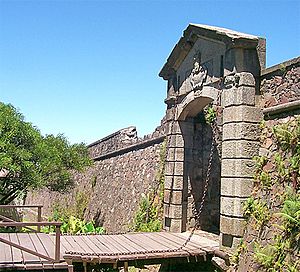
In 2013, 2.8 million tourists visited Uruguay. Most of them (59%) came from Argentina. Another 14% came from Brazil. Tourists from Chile, Paraguay, North America, and Europe made up most of the rest.
You can explore Uruguay's colonial history, like in Colonia del Sacramento. Montevideo, the capital, has many cultural activities. You can visit historical places like the Torres García Museum. The Estadio Centenario hosted the first World Cup. Just walking around the city lets you experience its lively culture.
Punta del Este is one of Uruguay's main natural attractions. It's on a small peninsula on the southeast coast. Its beaches are divided into two sides. The Mansa, or calm, side is like a river. The Brava, or rough, side faces the ocean. Mansa is good for sunbathing and snorkeling. Brava is better for exciting sports like surfing. Punta del Este is next to Maldonado city. To its northeast are smaller resorts like La Barra and José Ignacio.
Uruguay gets more tourists compared to its population than any other Latin American country. Tourism from Argentina is very important for Uruguay. It makes up 56% of all foreign tourists each year. During summer, it's 70%. While Argentine tourists are key, Uruguay has also attracted visitors from other countries. Many people now come from Brazil, Paraguay, and the United States.
Getting Around: Transportation in Uruguay
The Port of Montevideo handles over 1.1 million containers every year. It is the most modern container terminal in South America. Its dock can handle vessels with a draught of 14 meters (46 ft). Nine straddle cranes allow for 80 to 100 movements per hour. The port of Nueva Palmira is a major transfer point for goods in the region. It has both private and government-run terminals.
Carrasco International Airport first opened in 1947. In 2009, Puerta del Sur, the airport owner, invested $165 million. They hired Rafael Viñoly Architects to expand and update the airport. A new passenger terminal was built to increase capacity. This was meant to boost trade and tourism. The London-based magazine Frontier named Carrasco International Airport one of the world's top four airports. The airport can handle up to 4.5 million passengers per year. PLUNA was Uruguay's national airline. Its main office was in Carrasco.
The Punta del Este International Airport is 15 kilometers (9.3 mi) from Punta del Este. It is in the Maldonado Department. This is Uruguay's second busiest airport. It was designed by Uruguayan architect Carlos Ott and opened in 1997.
The Administración de Ferrocarriles del Estado manages rail transport. It also maintains the railroad network. Uruguay has about 1200 kilometers (750 mi) of working railroad track. Until 1947, British companies owned about 90% of the railway system. In 1949, the government took over the railways. They also took over electric trams and the Montevideo Waterworks Company. However, in 1985, a "National Transport Plan" said passenger trains were too expensive to fix. Cargo trains would continue for heavy loads. But bus transport became the cheaper option for travelers. Passenger service stopped in 1988. However, commuter rail service into Montevideo restarted in 1993. It now has three suburban lines.
Paved roads connect Montevideo to other cities. The main highways lead to the borders and nearby cities. Many unpaved roads connect farms and small towns. Trade by land has grown a lot since Mercosur (Southern Common Market) was formed in the 1990s. It grew even more in the 2000s. Most of the country's goods and passenger travel is by road, not rail.
Uruguay has several international bus services. They connect the capital and border towns to neighboring countries. There are 17 destinations in Argentina and 12 in Brazil. These include cities like Florianópolis and Porto Alegre. Buses also go to the capital cities of Chile and Paraguay.
Energy: Powering Uruguay
More than 97% of Uruguay's electricity comes from renewable energy. This big change happened in less than ten years. It did not need government funding. It lowered electricity costs and reduced the country's carbon footprint. Most electricity comes from hydroelectric plants and wind farms. Uruguay no longer needs to import electricity.
In 2021, Uruguay had a lot of installed renewable electricity. This included 1,538 MW from hydropower. It had 1,514 MW from wind power, making it 35th largest in the world. Solar power provided 258 MW, ranking 66th globally. Biomass contributed 423 MW.
People and Culture of Uruguay
Who Lives in Uruguay?
| Racial and ethnic composition in Uruguay (2011 census) | ||||
|---|---|---|---|---|
| Race/Color | ||||
| White | 87.7% | |||
| Black | 4.6% | |||
| Indigenous | 2.4% | |||
| East Asian | 0.2% | |||
| Other/none | 5.1% | |||
Most Uruguayans are of European background. In the 2011 census, over 87.7% of the people said they had European descent. Most Uruguayans with European ancestors came from Spain and Italy in the 1800s and 1900s. Fewer came from Germany, France, and Britain. Earlier settlers moved from Argentina. People of African descent make up about five percent of the total population. There are also important communities of Japanese people. Overall, the mix of ethnic groups is similar to nearby Argentine provinces and Southern Brazil.
From 1963 to 1985, about 320,000 Uruguayans moved away. The most common places for them to go were Argentina, then the United States, Australia, Canada, Spain, Italy, and France. In 2009, for the first time in 44 years, more people moved into Uruguay than left. In 2009, 3,825 residence permits were given out, compared to 1,216 in 2005. Half of the new legal residents came from Argentina and Brazil. A law passed in 2008 gives immigrants the same rights as citizens. They just need to show a monthly income of $650.
Uruguay's population growth is much slower than other Latin American countries. The average age is 35.3 years. This is higher than the global average. It's due to a low birth rate, long life expectancy, and many young people moving away. A quarter of the population is under 15 years old. About one-sixth are aged 60 or older. In 2017, the average total fertility rate (TFR) was 1.70 children per woman. This is below the 2.1 needed to replace the population. It is much lower than the high of 5.76 children per woman in 1882.
Metropolitan Montevideo is the only large city. It has about 1.9 million people. This is more than half of the country's total population. The rest of the city dwellers live in about 30 towns.
A 2017 report on work conditions in Latin America ranked Uruguay as the best in the region. It was a leader in almost all areas, including gender, age, income, and job participation.
Major Cities in Uruguay
|
Largest cities or towns in Uruguay
|
||
|---|---|---|
| Rank | Name | Pop. |
| 1 | Montevideo | 1,304,687 |
| 2 | Salto | 104,011 |
| 3 | Ciudad de la Costa | 95,176 |
| 4 | Paysandú | 76,412 |
| 5 | Las Piedras | 71,258 |
| 6 | Rivera | 64,465 |
| 7 | Maldonado | 62,590 |
| 8 | Tacuarembó | 54,755 |
| 9 | Melo | 51,830 |
| 10 | Mercedes | 41,974 |
Religion in Uruguay
| Religion in Uruguay (2021) | ||||
|---|---|---|---|---|
| Religion | Percent | |||
| Roman Catholicism | 44.8% | |||
| Protestant | 9.5% | |||
| Other religions | 1.2% | |||
| Unaffiliated | 44.5% | |||
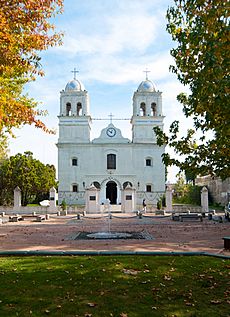
Christianity is the largest religion in Uruguay. The country has no official religion. The church and state are separate. Religious freedom is guaranteed for everyone.
Languages Spoken in Uruguay
Uruguayan Spanish is the main language. Like in Argentina, people use "voseo" (using "vos" instead of "tú") and "yeísmo" (pronouncing "ll" and "y" like "sh"). English is common in business. More young people are studying it now. Uruguayan Portuguese is spoken by 3% to 15% of Uruguayans. It is spoken in northern areas near the Brazilian border. This makes it the second most spoken language. Since there are few native people, no indigenous languages are thought to remain.
Another dialect spoken in the past was Patois. This was an Occitan dialect. It was mainly spoken in the Colonia Department. This is where the first pilgrims settled in a city called La Paz. Today, it is considered a dead language. However, some older people in La Paz still speak it. There are written records of the language in the Waldensians Library in Colonia Valdense.
Patois speakers came to Uruguay from the Piedmont region. They were originally Vaudois, who became Waldensians. This gave the city Colonia Valdense its name, meaning "Waldensian Colony."
In 2001, Uruguayan Sign Language (LSU) became an official language of Uruguay. This was under Law 17.378.
Education for Kids in Uruguay
Education in Uruguay is secular, free, and required for 14 years. It starts at age 4. The system has six levels: early childhood (ages 3–5), primary (6–11), basic secondary (12–14), upper secondary (15–17), higher education (18 and up), and post-graduate.
Three main groups are in charge of public education. The Ministry of Education and Culture plans education policies. The National Public Education Administration creates and carries out policies for early to secondary education. The University of the Republic is responsible for higher education. In 2009, the government planned to spend 4.5% of its GDP on education.
Uruguay scores well on tests like PISA in its region. However, it is lower than the average for OECD countries. It is also below some countries with similar income levels. In the 2006 PISA test, Uruguay had big differences in scores between schools. This suggests that a student's family income level affects their education.
Uruguay is part of the One Laptop per Child project. In 2009, it became the first country to give a laptop to every primary school student. This was part of the Plan Ceibal. From 2007 to 2009, 362,000 students and 18,000 teachers were part of the program. About 70% of the laptops went to children who did not have computers at home. The OLPC program costs less than 5% of the country's education budget.
Uruguayan Culture and Traditions
Uruguayan culture is very much like European culture. Influences from southern Europe are especially strong. The tradition of the gaucho (South American cowboy) is important in the art and stories of both Uruguay and Argentina.
Art and Visuals in Uruguay
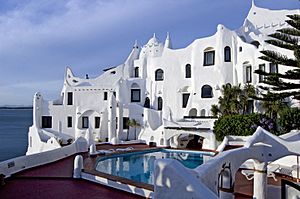
Carlos Páez Vilaró was a famous Uruguayan abstract painter and sculptor. He used ideas from places like Timbuktu and Mykonos to create his most famous work: his home, hotel, and art studio Casapueblo. It is near Punta del Este. Casapueblo is a "livable sculpture" and attracts thousands of visitors. The 19th-century painter Juan Manuel Blanes was the first Uruguayan artist to be widely known. His works show historical events. The Post-Impressionist painter Pedro Figari became famous around the world for his pastel drawings of Montevideo and the countryside. The landscape architect Leandro Silva Delgado also gained international fame for blending art and nature in his work.
Uruguay has a small but growing film industry. Movies like Whisky (2004) by Juan Pablo Rebella and Pablo Stoll, Los días con Ana (2000) by Marcelo Bertalmío, and Paisito (2008) by Ana Díez have won international awards. Paisito is about the 1973 military coup.
Music and Sounds of Uruguay
Uruguay's folk and popular music shares its gaucho roots with Argentina. It also shares the roots of the tango. One of the most famous tangos, "La cumparsita" (1917), was written by Uruguayan composer Gerardo Matos Rodríguez. The candombe is a folk dance performed at Carnival, especially Uruguayan Carnival. It is mainly danced by Uruguayans of African descent. The guitar is the favorite musical instrument. In a traditional contest called the payada, two singers take turns making up verses to the same tune, each with a guitar.
Folk music is called canto popular. It includes guitar players and singers like Alfredo Zitarrosa, José Carbajal "El Sabalero", Daniel Viglietti, Los Olimareños, and Numa Moraes.
Many radio stations and music events show how popular rock music and Caribbean genres are. These are known as música tropical ("tropical music"). Early classical music in Uruguay was heavily influenced by Spanish and Italian styles. But since the 1900s, many classical composers have used Latin American musical styles. These include Eduardo Fabini, Vicente Ascone, Héctor Tosar, and Eduardo Gilardoni. Montevideo has two symphony orchestras: OSSODRE and Filarmonica de Montevideo. Some well-known classical musicians are pianists Nibya Mariño, Dinorah Varsi, Alberto Reyes, Enrique Graf, Homero Francesch. Guitarists include Eduardo Fernandez, Alvaro Pierri, Marco Sartor. Conductors are Jose Serebrier, Carlos Kalmar. Singers include Maria Jose Siri, Carlo Ventre, Martin Nusspaumer, Maria Antunez, Erwin Schrott, Jose Lemos.
Tango has also influenced Uruguayan culture, especially in the 1930s and 1940s. Uruguayan singers like Julio Sosa from Las Piedras were famous. The well-known tango singer Carlos Gardel changed his nationality to Uruguayan when he was 29. He claimed he was born in Tacuarembó. This was likely to avoid being arrested by French authorities for not joining the French Army for World War I. Gardel was born in France and grew up in Buenos Aires. He never lived in Uruguay. Still, a Carlos Gardel museum opened in 1999 in Valle Edén, near Tacuarembó.
Rock and roll became popular in Uruguay in the early 1960s. This happened with the arrival of the Beatles and other British bands. Many bands appeared in Montevideo, like Los Shakers, Los Mockers, Los Iracundos, Los Moonlights, and Los Malditos. They became big names in the "Uruguayan Invasion" of Argentina. Popular bands from the Uruguayan Invasion sang in English.
Popular Uruguayan rock bands today include La Vela Puerca, No Te Va Gustar, El Cuarteto de Nos, Once Tiros, La Trampa, Chalamadre, Snake, Buitres, and Cursi. In 2004, Uruguayan musician and actor Jorge Drexler won an Academy Award. He wrote the song "Al otro lado del río" for the movie The Motorcycle Diaries. This movie was about the life of Che Guevara. Other famous Uruguayan songwriters are Jaime Roos, Eduardo Mateo, Rubén Rada, Pablo Sciuto, and Daniel Viglietti.
By mid-2015, Uruguayan bands Rombai and Márama became very successful. They played new styles called "cumbia cheta" and "cumbia pop." They were popular across Latin America even before releasing their first albums. They were especially big in Uruguay and Argentina. At one point, they had nine songs together in the Spotify Top Ten. Other successful Uruguayan bands include Toco Para Vos, Vi-Em, Toco Para Bailar, and Golden Rocket.
Delicious Uruguayan Food
Uruguayan food culture mostly comes from European cooking. Many Uruguayan dishes are from Spain, France, Italy, and Brazil. This is because many immigrants came from Europe due to past wars. Daily meals include meats, all kinds of pasta, rice, and sweet desserts. Meat is the main dish. Uruguay is one of the world's largest producers of high-quality meat.
Typical dishes include "Asado uruguayo" (a big grill or barbecue of different meats) and roasted lamb. A Chivito is a sandwich with thin grilled beef, lettuce, tomatoes, fried egg, ham, olives, and more. It is served with French fries. Milanesa is a type of fried breaded beef. Other common foods are tortellini, spaghetti, gnocchi, ravioli, rice, and vegetables.
One of the most eaten spreads in Uruguay is Dulce de leche. This is a caramel candy from Latin America. It is made by slowly heating sugar and milk. The most typical sweet is Alfajor. This is a small cake filled with Dulce de leche. It is covered with chocolate or meringue. It comes in many types, fillings, sizes, and brands. Other typical desserts include Pastafrola (a cake filled with quince jelly) and Chajá. Chajá has meringue, sponge cake, whipped cream, and fruits, usually peaches and strawberries.
Mate (drink) is the most typical drink in Uruguay. It is a portable drink that Uruguayans take everywhere.
Uruguayan Literature and Stories
José Enrique Rodó (1871–1917) was a modernist writer. He is considered Uruguay's most important literary figure. His book Ariel (1900) talks about keeping spiritual values while seeking material and technical progress. It also emphasizes resisting cultural control by Europe and the United States. The book still influences young writers today. Florencio Sánchez (1875–1910) was a notable Latin American playwright. He wrote plays about social problems of his time, which are still performed.
From around the same time came the romantic poetry of Juan Zorrilla de San Martín (1855–1931). He wrote epic poems about Uruguayan history. Also important are Juana de Ibarbourou (1895–1979), Delmira Agustini (1866–1914), Idea Vilariño (1920–2009), and the short stories of Horacio Quiroga and Juan José Morosoli (1899–1959). The psychological stories of Juan Carlos Onetti (like "No Man's Land" and "The Shipyard") have received much praise. The writings of Mario Benedetti are also highly regarded.
Uruguay's most famous modern writer is Eduardo Galeano. He wrote Las venas abiertas de América Latina (1971; "Open Veins of Latin America"). He also wrote the trilogy Memoria del fuego (1982–87; "Memory of Fire"). Other modern Uruguayan writers include Mario Levrero, Sylvia Lago, Jorge Majfud, and Jesús Moraes. Uruguayans from many backgrounds enjoy reading historietas. These are comic books that often mix humor and fantasy with hidden social criticism.
Sports and Games in Uruguay
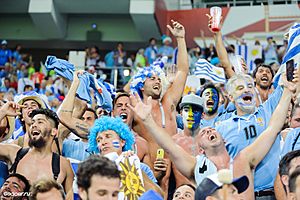
Football is the most popular sport in Uruguay. The first international football match outside the British Isles was played in Montevideo in July 1902. It was between Uruguay and Argentina. Uruguay won gold medals in football at the 1924 Paris Olympic Games and again in 1928 in Amsterdam.
The Uruguay national football team has won the FIFA World Cup twice. Uruguay won the first tournament at home in 1930. They won again in 1950, famously beating home favorites Brazil in the final match. Uruguay has won the Copa América (a South American tournament) 15 times, tied with Argentina. Their last win was in 2011. Uruguay has the smallest population of any country that has won a World Cup. Despite early success, they missed three World Cups out of four tries from 1994 to 2006. Uruguay did very well in the 2010 FIFA World Cup. They reached the semi-final for the first time in 40 years. Diego Forlán received the Golden Ball award as the best player of the 2010 tournament. In June 2012, Uruguay was ranked the second best team in the world by FIFA. This was their highest ranking ever, just behind the Spain national football team.
Uruguay sent 1,414 football players to other countries in the 2000s. This was almost as many as Brazil and Argentina. In 2010, the Uruguayan government took steps to keep players in the country.
English sailors and workers brought football to Uruguay in the late 1800s. They also tried to introduce rugby and cricket, but these were less successful. There are two major football clubs in Montevideo: Nacional and Peñarol. They have won many domestic and South American tournaments. Each has won three Intercontinental Cups. When these two clubs play each other, it's called the Uruguayan Clásico. It's the most important rivalry in Uruguay and one of the biggest in the Americas.
Besides football, basketball is also very popular in Uruguay. Its national team has qualified for the Basketball World Cup 7 times. This is more often than other South American countries, except Brazil and Argentina. Uruguay hosted the official Basketball World Cup in 1967. It also hosted the official Americas Basketball Championship in 1988, 1997, and is a host for the 2017 FIBA AmeriCup.
Images for kids
-
Juan Idiarte Borda (1844–1897), 17th President of Uruguay and the only one assassinated.
-
Ceibo (Erythrina crista-galli), the national flower in Uruguay.
-
Maldonado bay.
-
Palacio Legislativo, Montevideo, Uruguay.
-
Tabaré Vázquez (President 2005–2010, 2015–present) with then-President of Brazil Lula da Silva in 2007.
-
José Mujica (President 2010–2015) with then-President of Brazil Lula da Silva in 2010.
-
José Mujica with President of Brazil, Dilma Rouseff in 2011.
-
The local hot drink mate being consumed in transit.
See also
 In Spanish: Uruguay para niños
In Spanish: Uruguay para niños






